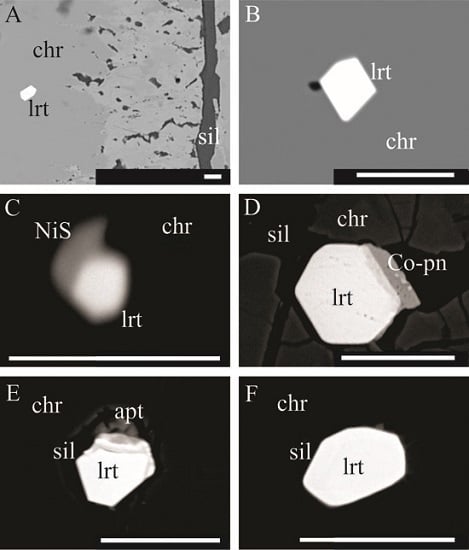Chromite Composition and Accessory Minerals in Chromitites from Sulawesi, Indonesia: Their Genetic Significance
Abstract
:1. Introduction
2. General Geology of the Sulawesi and Associated Ophiolite
3. Sample Provenance and Methodology
4. Results
4.1. Chromite Texture and Composition
4.2. Olivine
4.3. The Platinum-Group Minerals
5. Discussion
5.1. Parental Melt and Chromite Composition: Tectonic Implications
5.2. Origin of the PGM in the Sulawesi Chromitites
5.3. Olivine Composition and Its Significance
6. Summary and Concluding Remarks
Acknowledgments
Author Contributions
Conflicts of Interest
Appendixes
| Sample | Cr2O3 | Al2O3 | Fe2O3 | MgO | FeO | TiO2 | V2O3 | NiO | ZnO | Total |
|---|---|---|---|---|---|---|---|---|---|---|
| Alekale (Cr-rich) | ||||||||||
| 3a.1 | 58.53 | 11.35 | 1.35 | 11.53 | 16.30 | 0.22 | 0.09 | 0.15 | 0.11 | 99.64 |
| 3a.2 | 58.64 | 10.90 | 1.84 | 11.40 | 16.29 | 0.23 | 0.07 | 0.04 | 0.03 | 99.43 |
| 3a.3 | 58.74 | 11.04 | 1.37 | 11.30 | 16.61 | 0.32 | 0.13 | 0.02 | 0.03 | 99.55 |
| 3a.4 | 58.79 | 11.32 | 1.39 | 11.47 | 16.50 | 0.20 | 0.07 | 0.10 | 0.12 | 99.95 |
| 3a.5 | 58.99 | 10.78 | 1.56 | 11.28 | 16.44 | 0.20 | 0.11 | 0.06 | 0.00 | 99.41 |
| 3a.6 | 59.06 | 11.30 | 1.41 | 11.67 | 16.23 | 0.22 | 0.14 | 0.10 | 0.09 | 100.22 |
| 3a.7 | 59.55 | 11.11 | 0.88 | 11.29 | 16.69 | 0.28 | 0.15 | 0.08 | 0.19 | 100.21 |
| 3a.8 | 59.64 | 11.20 | 0.27 | 11.49 | 17.07 | 0.24 | 0.05 | 0.17 | 0.14 | 100.27 |
| 3a.9 | 59.82 | 11.06 | 0.73 | 11.35 | 17.04 | 0.26 | 0.02 | 0.14 | 0.05 | 100.46 |
| 3a.10 | 60.39 | 11.14 | 1.00 | 11.61 | 16.18 | 0.25 | 0.10 | 0.08 | 0.15 | 100.90 |
| Alekale (Al-rich) | ||||||||||
| 11a.1 | 41.12 | 24.04 | 3.48 | 10.76 | 19.24 | 0.07 | 0.30 | 0.09 | 0.11 | 99.22 |
| 11a.2 | 48.21 | 17.96 | 4.07 | 9.22 | 21.43 | 0.13 | 0.18 | 0.03 | 0.17 | 101.39 |
| 11a.3 | 43.33 | 21.16 | 5.26 | 10.00 | 20.02 | 0.14 | 0.14 | 0.06 | 0.19 | 100.30 |
| 11a.4 | 44.76 | 20.72 | 4.48 | 9.87 | 20.43 | 0.12 | 0.21 | 0.07 | 0.16 | 100.81 |
| 11a.5 | 42.63 | 23.16 | 4.08 | 10.66 | 19.30 | 0.11 | 0.19 | 0.08 | 0.23 | 100.44 |
| 11a.6 | 44.76 | 20.76 | 4.30 | 10.03 | 20.07 | 0.11 | 0.23 | 0.09 | 0.22 | 100.55 |
| 11a.7 | 42.74 | 21.48 | 5.12 | 10.05 | 20.01 | 0.12 | 0.22 | 0.11 | 0.09 | 99.94 |
| 11a.8 | 41.68 | 22.74 | 5.09 | 10.55 | 19.35 | 0.13 | 0.17 | 0.12 | 0.19 | 100.03 |
| 11a.9 | 42.25 | 22.37 | 4.91 | 10.30 | 19.67 | 0.14 | 0.22 | 0.13 | 0.17 | 100.14 |
| 11a.10 | 42.82 | 21.80 | 4.81 | 10.28 | 19.57 | 0.13 | 0.18 | 0.20 | 0.13 | 99.92 |
| Bette | ||||||||||
| 6a.1 | 43.69 | 17.47 | 8.61 | 11.09 | 17.90 | 0.53 | 0.23 | 0.14 | 0.11 | 99.77 |
| 6a.2 | 44.25 | 16.91 | 7.67 | 10.80 | 17.95 | 0.54 | 0.11 | 0.07 | 0.06 | 98.33 |
| 6a.3 | 44.95 | 16.81 | 7.21 | 10.70 | 18.44 | 0.48 | 0.23 | 0.09 | 0.14 | 99.05 |
| 6a.4 | 44.93 | 17.10 | 7.50 | 10.70 | 18.53 | 0.51 | 0.28 | 0.14 | 0.11 | 99.79 |
| 6a.5 | 45.20 | 16.85 | 6.94 | 10.50 | 19.24 | 0.49 | 0.27 | 0.19 | 0.17 | 99.84 |
| 6a.6 | 45.76 | 16.91 | 7.46 | 10.94 | 18.59 | 0.46 | 0.19 | 0.10 | 0.07 | 100.40 |
| 6a.7 | 44.24 | 17.20 | 7.28 | 10.86 | 18.30 | 0.51 | 0.29 | 0.22 | 0.09 | 98.98 |
| 6a.8 | 45.50 | 16.85 | 6.94 | 10.15 | 19.33 | 0.50 | 0.25 | 0.11 | 0.15 | 99.78 |
| 6a.9 | 44.39 | 17.72 | 6.91 | 11.55 | 18.87 | 0.52 | 0.11 | 0.05 | 0.83 | 100.82 |
| 6a.10 | 44.46 | 16.87 | 7.83 | 10.84 | 18.36 | 0.53 | 0.26 | 0.10 | 0.19 | 99.45 |
| 6b.1 | 44.79 | 17.14 | 7.81 | 11.07 | 18.09 | 0.48 | 0.21 | 0.12 | 0.25 | 99.96 |
| 6b.2 | 44.82 | 16.55 | 8.15 | 10.71 | 18.10 | 0.57 | 0.12 | 0.18 | 0.26 | 99.47 |
| 6b.3 | 44.83 | 16.96 | 7.64 | 10.73 | 18.17 | 0.52 | 0.19 | 0.17 | 0.16 | 99.37 |
| 6b.4 | 44.93 | 16.92 | 7.30 | 10.39 | 18.96 | 0.47 | 0.27 | 0.09 | 0.12 | 99.46 |
| 6b.5 | 44.96 | 16.68 | 7.68 | 10.81 | 18.24 | 0.50 | 0.26 | 0.09 | 0.10 | 99.32 |
| 6b.6 | 44.96 | 17.05 | 7.56 | 10.71 | 18.73 | 0.53 | 0.24 | 0.05 | 0.12 | 99.95 |
| 6b.7 | 45.20 | 16.70 | 7.40 | 10.47 | 18.29 | 0.46 | 0.16 | 0.28 | 0.16 | 99.12 |
| 6b.8 | 45.20 | 16.95 | 7.24 | 10.79 | 18.91 | 0.50 | 0.22 | 0.08 | 0.05 | 99.95 |
| 6b.9 | 45.36 | 16.11 | 8.20 | 10.58 | 18.21 | 0.47 | 0.22 | 0.24 | 0.15 | 99.53 |
| 6b.10 | 45.52 | 16.35 | 7.31 | 10.59 | 18.59 | 0.48 | 0.26 | 0.18 | 0.10 | 99.39 |
| Jempulu | ||||||||||
| 1a.1 | 56.88 | 10.67 | 3.07 | 9.68 | 19.38 | 0.19 | 0.14 | 0.06 | 0.12 | 100.19 |
| 1a.2 | 58.30 | 8.02 | 4.86 | 9.14 | 19.53 | 0.13 | 0.18 | 0.02 | 0.11 | 100.29 |
| 1a.3 | 56.47 | 8.06 | 6.33 | 8.52 | 20.87 | 0.29 | 0.20 | 0.06 | 0.09 | 100.89 |
| 1a.4 | 57.39 | 10.63 | 1.95 | 9.44 | 19.44 | 0.17 | 0.14 | 0.04 | 0.13 | 99.33 |
| 1a.5 | 56.53 | 10.96 | 3.81 | 9.82 | 19.03 | 0.18 | 0.09 | 0.03 | 0.06 | 100.49 |
| 1a.6 | 56.04 | 10.99 | 2.90 | 9.40 | 19.03 | 0.17 | 0.14 | 0.09 | 0.20 | 98.94 |
| 1a.7 | 56.80 | 11.20 | 2.63 | 9.81 | 19.03 | 0.20 | 0.15 | 0.10 | 0.11 | 100.03 |
| 1a.8 | 56.07 | 11.20 | 3.54 | 9.99 | 18.33 | 0.19 | 0.10 | 0.19 | 0.07 | 99.69 |
| 1a.9 | 56.58 | 11.47 | 3.04 | 10.11 | 18.39 | 0.17 | 0.11 | 0.12 | 0.04 | 100.03 |
| 1a.10 | 54.26 | 12.36 | 3.64 | 9.99 | 18.37 | 0.16 | 0.09 | 0.04 | 0.12 | 99.03 |
| Kalamasse | ||||||||||
| 7a.1 | 47.07 | 18.99 | 4.93 | 13.28 | 14.67 | 0.28 | 0.13 | 0.15 | 0.08 | 99.59 |
| 7a.2 | 47.25 | 19.34 | 4.87 | 13.51 | 14.43 | 0.29 | 0.19 | 0.16 | 0.12 | 100.15 |
| 7a.3 | 47.43 | 19.02 | 4.70 | 13.14 | 14.81 | 0.31 | 0.08 | 0.13 | 0.20 | 99.82 |
| 7a.4 | 47.47 | 19.13 | 4.56 | 13.38 | 14.42 | 0.28 | 0.17 | 0.23 | 0.06 | 99.71 |
| 7a.5 | 47.63 | 18.87 | 4.89 | 13.41 | 14.59 | 0.32 | 0.17 | 0.14 | 0.05 | 100.07 |
| 7a.6 | 47.69 | 18.38 | 5.51 | 13.25 | 14.97 | 0.31 | 0.08 | 0.11 | 0.06 | 100.35 |
| 7a.7 | 48.03 | 18.83 | 4.45 | 13.24 | 15.34 | 0.33 | 0.15 | 0.12 | 0.12 | 100.60 |
| 7a.8 | 48.09 | 18.96 | 3.74 | 13.24 | 15.45 | 0.28 | 0.11 | 0.14 | 0.18 | 100.20 |
| 7a.9 | 48.23 | 18.67 | 4.64 | 13.16 | 15.17 | 0.31 | 0.22 | 0.08 | 0.00 | 100.47 |
| 7a.10 | 48.61 | 18.57 | 3.95 | 12.97 | 15.59 | 0.33 | 0.17 | 0.19 | 0.18 | 100.57 |
| 2b.1 | 47.63 | 19.90 | 3.58 | 12.72 | 15.55 | 0.19 | 0.14 | 0.24 | 0.12 | 100.06 |
| 2b.2 | 47.67 | 19.48 | 3.57 | 12.73 | 15.63 | 0.18 | 0.14 | 0.03 | 0.07 | 99.48 |
| 2b.3 | 47.88 | 19.46 | 3.10 | 12.46 | 15.73 | 0.19 | 0.18 | 0.15 | 0.10 | 99.24 |
| 2b.4 | 48.01 | 19.55 | 3.13 | 12.36 | 15.97 | 0.18 | 0.16 | 0.24 | 0.06 | 99.66 |
| 2b.5 | 48.02 | 19.26 | 3.67 | 12.44 | 16.00 | 0.16 | 0.16 | 0.03 | 0.11 | 99.85 |
| 2b.6 | 48.14 | 19.14 | 3.03 | 12.49 | 15.77 | 0.17 | 0.17 | 0.08 | 0.02 | 99.00 |
| 2b.7 | 48.16 | 19.31 | 2.33 | 12.12 | 16.73 | 0.16 | 0.18 | 0.05 | 0.03 | 99.06 |
| 2b.8 | 48.30 | 19.97 | 2.33 | 12.60 | 16.04 | 0.19 | 0.13 | 0.09 | 0.18 | 99.84 |
| 2b.9 | 48.39 | 19.72 | 2.65 | 12.46 | 15.89 | 0.21 | 0.14 | 0.18 | 0.16 | 99.80 |
| 2b.10 | 49.17 | 19.62 | 2.28 | 12.67 | 16.24 | 0.18 | 0.15 | 0.11 | 0.06 | 100.48 |
| 9b.1 | 48.08 | 19.43 | 2.83 | 11.85 | 17.95 | 0.20 | 0.16 | 0.15 | 0.12 | 100.78 |
| 9b.2 | 47.51 | 19.70 | 3.58 | 12.00 | 17.13 | 0.21 | 0.16 | 0.21 | 0.13 | 100.64 |
| 9b.3 | 48.04 | 18.73 | 3.81 | 11.64 | 17.06 | 0.17 | 0.10 | 0.07 | 0.13 | 99.76 |
| 9b.4 | 48.28 | 18.57 | 3.78 | 11.76 | 17.41 | 0.20 | 0.14 | 0.14 | 0.19 | 100.47 |
| 9b.5 | 48.28 | 18.65 | 3.82 | 11.57 | 17.39 | 0.18 | 0.10 | 0.09 | 0.10 | 100.19 |
| 9b.6 | 49.02 | 18.37 | 3.63 | 11.32 | 17.71 | 0.19 | 0.12 | 0.19 | 0.10 | 100.65 |
| 9b.7 | 48.77 | 18.76 | 3.45 | 11.66 | 17.39 | 0.22 | 0.11 | 0.17 | 0.14 | 100.66 |
| 9b.8 | 48.86 | 18.88 | 3.08 | 11.74 | 17.54 | 0.23 | 0.15 | 0.14 | 0.06 | 100.69 |
| 9b.9 | 49.40 | 19.32 | 3.01 | 11.91 | 17.46 | 0.20 | 0.12 | 0.14 | 0.10 | 101.66 |
| 9b.10 | 49.76 | 18.66 | 3.02 | 10.63 | 18.10 | 0.08 | 0.11 | 0.06 | 0.19 | 100.60 |
| Kamara | ||||||||||
| 13a.1 | 59.08 | 10.90 | 1.48 | 11.37 | 16.47 | 0.20 | 0.08 | 0.14 | 0.05 | 99.77 |
| 13a.2 | 60.77 | 9.90 | 1.29 | 11.10 | 16.90 | 0.19 | 0.09 | 0.20 | 0.14 | 100.59 |
| 13a.3 | 58.91 | 11.27 | 1.31 | 11.53 | 16.40 | 0.21 | 0.10 | 0.24 | 0.06 | 100.03 |
| 13a.4 | 60.21 | 9.84 | 1.84 | 11.22 | 16.54 | 0.22 | 0.13 | 0.09 | 0.06 | 100.14 |
| 13a.5 | 60.76 | 10.00 | 0.54 | 10.86 | 17.18 | 0.19 | 0.04 | 0.01 | 0.06 | 99.64 |
| 13a.6 | 57.59 | 11.68 | 1.75 | 11.53 | 15.98 | 0.20 | 0.12 | 0.13 | 0.07 | 99.04 |
| 13a.7 | 58.33 | 11.51 | 1.81 | 11.58 | 16.06 | 0.22 | 0.14 | 0.16 | 0.12 | 99.92 |
| 13a.8 | 57.86 | 11.56 | 1.26 | 11.59 | 16.31 | 0.24 | 0.06 | 0.16 | 0.04 | 99.07 |
| 13a.9 | 58.32 | 11.58 | 1.36 | 11.27 | 16.48 | 0.22 | 0.11 | 0.15 | 0.08 | 99.56 |
| 13a.10 | 59.95 | 9.74 | 1.35 | 10.69 | 17.07 | 0.21 | 0.09 | 0.08 | 0.19 | 99.38 |
| Palakka | ||||||||||
| 12b.1 | 57.11 | 12.35 | 1.73 | 11.89 | 15.51 | 0.24 | 0.09 | 0.20 | 0.06 | 99.19 |
| 12b.2 | 57.46 | 12.57 | 1.97 | 12.19 | 15.52 | 0.26 | 0.17 | 0.16 | 0.05 | 100.35 |
| 12b.3 | 57.84 | 12.44 | 1.61 | 12.17 | 15.69 | 0.26 | 0.06 | 0.20 | 0.08 | 100.37 |
| 12b.4 | 57.15 | 12.57 | 2.50 | 12.26 | 15.39 | 0.25 | 0.08 | 0.11 | 0.16 | 100.47 |
| 12b.5 | 57.65 | 12.40 | 2.46 | 12.44 | 15.14 | 0.25 | 0.04 | 0.18 | 0.08 | 100.64 |
| 12b.6 | 56.48 | 12.41 | 1.83 | 11.85 | 15.68 | 0.25 | 0.08 | 0.15 | 0.21 | 98.93 |
| 12b.7 | 56.36 | 12.58 | 2.32 | 12.30 | 15.03 | 0.23 | 0.03 | 0.23 | 0.12 | 99.19 |
| 12b.8 | 56.33 | 12.58 | 2.68 | 12.46 | 14.98 | 0.27 | 0.04 | 0.18 | 0.17 | 99.69 |
| 12b.9 | 57.18 | 12.69 | 2.08 | 12.17 | 15.51 | 0.25 | 0.08 | 0.17 | 0.05 | 100.16 |
| 12b.10 | 58.14 | 12.43 | 1.38 | 11.95 | 16.13 | 0.28 | 0.11 | 0.19 | 0.17 | 100.77 |
| Sample | Cr2O3 | Al2O3 | Fe2O3 | MgO | FeO | TiO2 | V2O3 | NiO | ZnO | Total |
|---|---|---|---|---|---|---|---|---|---|---|
| Latao | ||||||||||
| 15b.1 | 63.52 | 9.30 | 0.00 | 10.67 | 15.85 | 0.14 | 0.16 | 0.09 | 0.05 | 99.78 |
| 15b.2 | 64.65 | 7.91 | 0.00 | 11.16 | 16.18 | 0.14 | 0.12 | 0.06 | 0.15 | 100.35 |
| 15b.3 | 61.54 | 9.05 | 2.39 | 12.57 | 14.57 | 0.15 | 0.21 | 0.06 | 0.04 | 100.57 |
| 15b.4 | 64.77 | 8.23 | 0.00 | 11.43 | 15.66 | 0.15 | 0.19 | 0.13 | 0.04 | 100.59 |
| 15b.5 | 65.29 | 8.25 | 0.00 | 11.59 | 15.97 | 0.17 | 0.12 | 0.06 | 0.19 | 101.64 |
| 15b.6 | 64.23 | 8.27 | 0.00 | 11.50 | 15.38 | 0.14 | 0.05 | 0.04 | 0.12 | 99.73 |
| 15b.7 | 64.54 | 8.19 | 0.00 | 11.38 | 15.44 | 0.13 | 0.10 | 0.01 | 0.08 | 99.87 |
| 15b.8 | 63.60 | 8.55 | 0.03 | 11.82 | 15.51 | 0.15 | 0.09 | 0.02 | 0.11 | 99.88 |
| 15b.9 | 63.82 | 8.73 | 0.00 | 11.79 | 15.12 | 0.15 | 0.14 | 0.10 | 0.08 | 99.91 |
| 15b.10 | 64.38 | 8.83 | 0.00 | 11.70 | 15.61 | 0.16 | 0.09 | 0.04 | 0.09 | 100.86 |
| 14a.1 | 60.17 | 9.21 | 3.12 | 12.80 | 13.86 | 0.14 | 0.09 | 0.16 | 0.08 | 99.63 |
| 14a.2 | 60.48 | 9.02 | 1.86 | 12.39 | 14.82 | 0.17 | 0.20 | 0.06 | 0.13 | 99.11 |
| 14a.3 | 60.73 | 9.43 | 2.42 | 12.75 | 13.82 | 0.15 | 0.09 | 0.13 | 0.20 | 99.73 |
| 14a.4 | 60.22 | 9.20 | 2.42 | 12.67 | 14.21 | 0.20 | 0.14 | 0.11 | 0.17 | 99.34 |
| 14a.5 | 60.30 | 9.12 | 2.49 | 12.60 | 14.03 | 0.14 | 0.12 | 0.25 | 0.17 | 99.23 |
| 14a.6 | 60.41 | 9.22 | 2.85 | 12.76 | 13.73 | 0.18 | 0.19 | 0.32 | 0.11 | 99.78 |
| 14a.7 | 60.55 | 9.13 | 2.31 | 12.70 | 14.12 | 0.16 | 0.11 | 0.11 | 0.09 | 99.29 |
| 14a.8 | 60.59 | 9.12 | 2.62 | 12.50 | 14.14 | 0.16 | 0.11 | 0.05 | 0.15 | 99.42 |
| 14a.9 | 60.81 | 9.09 | 2.57 | 12.50 | 14.15 | 0.16 | 0.10 | 0.17 | 0.07 | 99.62 |
| 14a.10 | 61.25 | 9.14 | 2.63 | 12.82 | 14.15 | 0.16 | 0.15 | 0.17 | 0.18 | 100.64 |
| 10a.1 | 62.81 | 9.36 | 0.29 | 11.30 | 16.94 | 0.15 | 0.22 | 0.03 | 0.05 | 101.15 |
| 10a.2 | 63.10 | 9.43 | 0.38 | 11.39 | 16.78 | 0.16 | 0.16 | 0.06 | 0.08 | 101.54 |
| 10a.3 | 62.92 | 9.28 | 0.67 | 11.40 | 16.46 | 0.14 | 0.17 | 0.11 | 0.06 | 101.20 |
| 10a.4 | 63.07 | 9.25 | 0.00 | 11.13 | 16.63 | 0.15 | 0.17 | 0.03 | 0.03 | 100.46 |
| 10a.5 | 62.63 | 9.53 | 0.43 | 11.38 | 16.49 | 0.19 | 0.11 | 0.18 | 0.09 | 101.02 |
| 10a.6 | 62.43 | 9.15 | 0.87 | 11.24 | 16.57 | 0.16 | 0.17 | 0.05 | 0.07 | 100.70 |
| 10a.7 | 62.28 | 9.46 | 0.34 | 11.22 | 17.00 | 0.14 | 0.14 | 0.12 | 0.03 | 100.71 |
| 10a.8 | 63.05 | 9.57 | 0.00 | 11.05 | 16.67 | 0.17 | 0.14 | 0.00 | 0.03 | 100.68 |
| 10a.9 | 62.34 | 9.29 | 0.00 | 11.06 | 16.97 | 0.18 | 0.13 | 0.16 | 0.06 | 100.20 |
| 10a.10 | 63.13 | 9.39 | 0.00 | 11.04 | 16.75 | 0.17 | 0.18 | 0.12 | 0.09 | 100.87 |
| Soroako | ||||||||||
| 5b.1 | 56.17 | 12.53 | 3.09 | 12.11 | 15.80 | 0.19 | 0.08 | 0.11 | 0.04 | 100.11 |
| 5b.2 | 56.65 | 12.83 | 2.33 | 13.23 | 13.34 | 0.18 | 0.13 | 0.20 | 0.14 | 99.02 |
| 5b.3 | 56.81 | 12.93 | 2.13 | 13.00 | 13.92 | 0.20 | 0.16 | 0.13 | 0.18 | 99.47 |
| 5b.4 | 56.96 | 12.50 | 1.21 | 12.77 | 14.74 | 0.18 | 0.19 | 0.10 | 0.14 | 98.78 |
| 5b.5 | 56.98 | 12.84 | 1.85 | 13.23 | 14.20 | 0.19 | 0.24 | 0.18 | 0.11 | 99.83 |
| 5b.6 | 57.11 | 12.65 | 2.39 | 13.45 | 13.25 | 0.18 | 0.11 | 0.19 | 0.05 | 99.37 |
| 5b.7 | 57.13 | 12.87 | 2.48 | 13.14 | 13.95 | 0.20 | 0.13 | 0.10 | 0.16 | 100.17 |
| 5b.8 | 57.20 | 12.75 | 1.84 | 13.33 | 13.89 | 0.18 | 0.11 | 0.18 | 0.12 | 99.61 |
| 5b.9 | 57.42 | 13.19 | 1.66 | 13.30 | 13.60 | 0.18 | 0.07 | 0.12 | 0.13 | 99.67 |
| 5b.10 | 57.59 | 12.66 | 2.14 | 13.51 | 13.82 | 0.21 | 0.14 | 0.10 | 0.11 | 100.29 |
| Sample | SiO2 | MgO | FeO | Cr2O3 | MnO | NiO | Total | Fo (%) | Ca (ppm) |
|---|---|---|---|---|---|---|---|---|---|
| Included | |||||||||
| Soroako | |||||||||
| 5a.3 | 41.58 | 52.91 | 2.90 | 0.34 | 0.05 | 0.92 | 98.69 | 97.01 | 100 |
| 5a.4 | 41.79 | 53.50 | 2.88 | 0.32 | 0.05 | 1.00 | 99.54 | 97.07 | 150 |
| 5a.9 | 41.74 | 52.63 | 2.91 | 0.42 | 0.03 | 0.95 | 98.69 | 96.99 | 100 |
| Palakka | |||||||||
| 12b.12 | 41.91 | 53.53 | 2.79 | 0.44 | 0.01 | 0.91 | 99.59 | 97.16 | 130 |
| 12b.13 | 42.26 | 53.84 | 2.90 | 0.28 | 0.01 | 0.90 | 100.19 | 97.07 | 130 |
| 12b.19 | 42.37 | 53.42 | 2.80 | 0.30 | 0.04 | 0.84 | 99.77 | 97.14 | 70 |
| 12b.20 | 42.27 | 53.36 | 2.77 | 0.34 | 0.02 | 0.93 | 99.70 | 97.17 | 50 |
| Interstitial | |||||||||
| Soroako | |||||||||
| 5a.2 | 42.33 | 53.23 | 3.32 | 0.21 | 0.03 | 0.67 | 99.78 | 96.62 | 200 |
| 5a.3 | 42.79 | 52.79 | 3.55 | 0.17 | 0.06 | 0.69 | 100.05 | 96.36 | 160 |
| 5a.5 | 42.64 | 53.11 | 3.95 | 0.07 | 0.05 | 0.64 | 100.45 | 96.00 | 110 |
| 5a.6 | 42.45 | 53.60 | 3.92 | 0.02 | 0.06 | 0.76 | 100.81 | 96.06 | 90 |
| 5a.7 | 42.56 | 52.68 | 3.48 | 0.09 | 0.08 | 0.75 | 99.64 | 96.43 | 400 |
| 5a.8 | 42.98 | 53.45 | 3.81 | 0.06 | 0.04 | 0.65 | 100.99 | 96.15 | 360 |
| 5a.9 | 42.12 | 52.31 | 4.11 | 0.05 | 0.05 | 0.63 | 99.27 | 95.78 | 400 |
| 5a.10 | 42.23 | 53.30 | 3.57 | 0.06 | 0.05 | 0.79 | 100.00 | 96.38 | 230 |
| 5a.12 | 41.85 | 52.99 | 4.69 | 0.02 | 0.07 | 0.60 | 100.22 | 95.27 | 340 |
| 5a.13 | 42.14 | 52.45 | 4.73 | 0.04 | 0.08 | 0.55 | 99.99 | 95.19 | 310 |
| 5a.16 | 41.95 | 52.39 | 5.49 | 0.03 | 0.08 | 0.60 | 100.54 | 94.45 | 430 |
| 5a.17 | 42.02 | 52.75 | 5.40 | 0.02 | 0.10 | 0.53 | 100.82 | 94.57 | 440 |
| 5a.18 | 42.61 | 52.39 | 4.99 | 0.04 | 0.10 | 0.51 | 100.64 | 94.93 | 480 |
| 5a.19 | 42.31 | 52.71 | 4.90 | 0.02 | 0.07 | 0.56 | 100.57 | 95.05 | 320 |
| 5a.20 | 42.28 | 52.51 | 4.99 | 0.02 | 0.05 | 0.51 | 100.37 | 94.94 | 460 |
| Kalamasse | |||||||||
| 2a.1 | 41.92 | 54.51 | 2.58 | 0.69 | 0.03 | 0.78 | 100.51 | 97.42 | 140 |
| 2a.2 | 42.04 | 52.84 | 3.65 | 0.27 | 0.03 | 0.65 | 99.48 | 96.27 | 790 |
| 2a.3 | 41.58 | 53.43 | 3.35 | 0.32 | 0.03 | 0.63 | 99.34 | 96.60 | 640 |
| 2a.4 | 42.08 | 53.26 | 3.50 | 0.28 | 0.05 | 0.65 | 99.82 | 96.45 | 740 |
| 2a.5 | 42.18 | 52.46 | 2.76 | 0.89 | 0.04 | 0.79 | 99.10 | 97.14 | 170 |
| 2a.6 | 42.05 | 53.18 | 2.67 | 0.95 | 0.04 | 0.78 | 99.67 | 97.26 | 190 |
| 2a.9 | 42.31 | 54.07 | 2.81 | 0.58 | 0.03 | 0.79 | 100.59 | 97.17 | 380 |
| 2a.10 | 42.37 | 53.38 | 2.64 | 0.50 | 0.04 | 0.64 | 99.58 | 97.30 | 360 |
| 2a.11 | 42.39 | 54.28 | 2.65 | 0.62 | 0.06 | 0.79 | 100.78 | 97.34 | 210 |
| Latao | |||||||||
| 15b.2 | 41.67 | 53.52 | 3.87 | 0.80 | 0.05 | 0.59 | 100.49 | 95.97 | 80 |
| 15b.3 | 42.32 | 54.05 | 4.04 | 0.96 | 0.06 | 0.61 | 102.04 | 95.98 | 80 |
| Sample | S | As | Os | Ir | Ru | Rh | Pd | Pt | Fe | Ni | Cu | Total |
|---|---|---|---|---|---|---|---|---|---|---|---|---|
| Palakka | ||||||||||||
| 12b.3 | 33.07 | 1.72 | 20.97 | 4.65 | 30.29 | 2.55 | 2.52 | 0.00 | 1.14 | 0.29 | 0.10 | 97.31 |
| 12b.4 | 33.21 | 1.77 | 20.27 | 5.84 | 31.67 | 2.57 | 2.64 | 0.00 | 0.94 | 0.19 | 0.06 | 99.17 |
| Kamara | ||||||||||||
| 13a.1 | 34.99 | 2.02 | 18.59 | 3.25 | 36.85 | 2.06 | 2.45 | 0.00 | 0.80 | 0.16 | 0.06 | 101.24 |
| Latao | ||||||||||||
| 14a.1 | 32.51 | 1.12 | 21.58 | 12.68 | 27.97 | 1.20 | 1.62 | 0.00 | 1.07 | 0.04 | 0.13 | 99.92 |
| Kalamasse | ||||||||||||
| 7a.3 | 34.18 | 1.26 | 20.62 | 2.18 | 35.13 | 1.36 | 2.04 | 0.00 | 1.42 | 0.26 | 0.02 | 98.47 |
| 7a.4 | 34.09 | 1.06 | 24.84 | 0.00 | 35.00 | 1.27 | 2.01 | 0.00 | 0.91 | 0.15 | 0.02 | 99.36 |
| 7a.5 | 34.16 | 1.01 | 24.37 | 0.48 | 33.26 | 1.29 | 1.88 | 0.00 | 1.36 | 0.17 | 0.01 | 97.99 |
| 7a.6 | 33.69 | 1.26 | 24.47 | 1.00 | 33.80 | 1.65 | 1.96 | 0.00 | 1.01 | 0.13 | 0.06 | 99.03 |
| 7a.6 | 34.14 | 1.46 | 21.30 | 1.78 | 35.83 | 1.42 | 2.09 | 0.00 | 0.93 | 0.27 | 0.04 | 99.26 |
| 7b.2 | 34.68 | 1.02 | 17.93 | 4.93 | 34.97 | 1.53 | 2.02 | 0.00 | 1.60 | 0.23 | 0.10 | 99.01 |
| 9a.1 | 34.99 | 1.43 | 19.48 | 5.28 | 31.47 | 2.22 | 2.26 | 0.00 | 2.11 | 0.42 | 0.14 | 99.81 |
| Sample | S | As | Os | Ir | Ru | Rh | Pd | Pt | Fe | Ni | Cu | |
| Palakka | ||||||||||||
| 12b.3 | 65.94 | 1.47 | 7.05 | 1.55 | 19.16 | 1.58 | 1.51 | 0.00 | 1.31 | 0.32 | 0.10 | |
| 12b.4 | 65.53 | 1.50 | 6.74 | 1.92 | 19.82 | 1.58 | 1.57 | 0.00 | 1.07 | 0.21 | 0.06 | |
| Kamara | ||||||||||||
| 13a.1 | 65.80 | 1.63 | 5.89 | 1.02 | 21.98 | 1.21 | 1.39 | 0.00 | 0.87 | 0.16 | 0.06 | |
| Latao | ||||||||||||
| 14a.1 | 66.10 | 0.98 | 7.40 | 4.30 | 18.05 | 0.76 | 0.99 | 0.00 | 1.25 | 0.05 | 0.13 | |
| Kalamasse | ||||||||||||
| 7a.3 | 66.10 | 1.04 | 6.72 | 0.70 | 21.55 | 0.82 | 1.19 | 0.00 | 1.58 | 0.28 | 0.02 | |
| 7a.4 | 66.25 | 0.88 | 8.14 | 0.00 | 21.58 | 0.77 | 1.18 | 0.00 | 1.02 | 0.16 | 0.02 | |
| 7a.5 | 66.74 | 0.84 | 8.03 | 0.16 | 20.62 | 0.79 | 1.11 | 0.00 | 1.53 | 0.18 | 0.01 | |
| 7a.6 | 66.02 | 1.06 | 8.08 | 0.33 | 21.01 | 1.01 | 1.16 | 0.00 | 1.14 | 0.14 | 0.06 | |
| 7a.6 | 65.92 | 1.21 | 6.93 | 0.57 | 21.95 | 0.85 | 1.22 | 0.00 | 1.03 | 0.29 | 0.04 | |
| 7b.2 | 66.39 | 0.84 | 5.79 | 1.57 | 21.24 | 0.91 | 1.17 | 0.00 | 1.76 | 0.24 | 0.10 | |
| 9a.1 | 66.47 | 1.16 | 6.24 | 1.67 | 18.97 | 1.31 | 1.29 | 0.00 | 2.30 | 0.44 | 0.14 | |
References
- Stumpfl, E.F.; Clark, A.M. Electron-probe microanalysis of glod-platinoid concentrations from Southeast Borneo. Trans. Inst. Min. Metall. 1965, 74, 933–946. [Google Scholar]
- Burgath, K.P.; Mohr, M. Chromitites and platinum-group minerals in the Meratus-Bobaris ophiolite zone, southeast Borneo. Metallog. Basic Ultrabasic Rocks 1986, 1986, 333–349. [Google Scholar]
- Burgath, K.P. Platinum-Group Minerals in Ophiolitic Chromitites and Alluvial Placer Deposits, Meratus-Bobaris Area, Southeast Kalimantan; Prichard, H.M., Potts, P.J., Bowles, J.F.W., Cribb, S.J., Eds.; Springer: Rotterdam, The Netherlands, 1988; pp. 383–403. [Google Scholar]
- Hattori, K.H.; Cabri, L.J.; Johanson, B.; Zientek, M.L. Origin of placer laurite from Borneo: Se and As contents, and S isotopic compositions. Mineral. Mag. 2004, 68, 353–368. [Google Scholar] [CrossRef]
- Zientek, M.L.; Pardiartob, B.; Simandjuntakb, H.R.W.; Wikramac, A.; Oscarsond, R.L.; Meiere, A.L.; Carlsone, R.R. Placer and lode platinum-group minerals in south Kalimantan, Indonesia: Evidence for derivation from Alaskan-type ultramafic intrusions. Aust. J. Earth Sci. 1992, 39, 405–417. [Google Scholar] [CrossRef]
- Bowles, J.F.W.; Cameron, N.R.; Beddoe-Stephens, B.; Young, R.D. Alluvial gold, platinum, osmium-iridium, copper-zinc and copper-tin alloys from Sumatra—Their composition and genesis. Inst. Min. Metall. Trans. 1984, 93, B23–B30. [Google Scholar]
- Stumpfl, F.E.; Tarkian, M. Vincentite, a new palladium mineral from south-east Borneo. Mineral. Mag. 1974, 39, 525–527. [Google Scholar] [CrossRef]
- Bowles, J.F.W.; Atkin, D.; Lambert, J.L.M.; Deans, T.; Phillips, R. The chemistry, reflectance, and cell size of the erlichmanite (OsS2)-laurite (RuS2) series. Mineral. Mag. 1983, 47, 465–471. [Google Scholar] [CrossRef]
- Garuti, G.; Zaccarini, F.; Economou-Eliopoulos, M. Paragenesis and composition of laurite in chromitites of Othrys (Greece): Implication for Os-Ru fractionation in ophiolitic upper mantle of the Balkan peninsula. Mineral. Depos. 1999, 34, 312–319. [Google Scholar] [CrossRef]
- Garuti, G.; Zaccarini, F.; Moloshag, V.; Alimov, V. Platinum-Group minerals as indicator of sulfur fugacity in ophiolitic upper mantle: An example from chromitites of the Ray-Iz ultramafic complex (Polar Urals, Russia). Can. Mineral. 1999, 37, 1099–1115. [Google Scholar]
- Brenan, J.M.; Andrews, D.R.A. High-temperature stability of laurite and Ru–Os–Ir alloys and their role in PGE fractionation in mafic magmas. Can. Mineral. 2001, 39, 341–360. [Google Scholar] [CrossRef]
- Garuti, G.; Zaccarini, F. In-situ alteration of platinum-group minerals at low temperature: Evidence from chromitites of the Vourinos complex (Greece). Can. Mineral. 1997, 35, 611–626. [Google Scholar]
- Garuti, G.; Proenza, J.A.; Zaccarini, F. Distribution and mineralogy of platinum-group elements in altered chromitites of the Campo Formoso layered intrusion (Bahia State, Brazil): Control by magmatic and hydrothermal processes. Mineral. Petrol. 2007, 86, 159–188. [Google Scholar] [CrossRef]
- Zaccarini, F.; Proenza, J.A.; Ortega-Gutierrez, F.; Garuti, G. Platinum Group Minerals in ophiolitic chromitites from Tehuitzingo (Acatlan Complex, Southern Mexico): Implications for postmagmatic modification. Mineral. Petrol. 2005, 84, 147–168. [Google Scholar] [CrossRef]
- Escayola, M.; Garuti, G.; Zaccarini, F.; Proenza, J.A.; Bedard, J.; van Staal, C. Chromitite and platinum-group element mineralization at Middle Arm Brook, central Advocate ophiolite complex (Baie Verte peninsula, Newfoundland, Canada). Can. Mineral. 2011, 49, 1523–1547. [Google Scholar] [CrossRef]
- Garuti, G.; Zaccarini, F.; Proenza, J.A.; Thalhammer, O.A.R.; Angeli, N. Platinum-Group Minerals in Chromitites of the Niquelândia Layered Intrusion (Central Goias, Brazil): Their magmatic origin and low-temperature reworking under serpentinization and lateritic weathering. Minerals 2012, 2, 365–384. [Google Scholar] [CrossRef]
- Irvine, T.N. Chromian spinel as a petrogenetic indicator. Part I. Theory. Can. J. Earth Sci. 1965, 2, 648–672. [Google Scholar] [CrossRef]
- Irvine, T.N. Chromian spinel as a petrogenetic indicator. Part II. Petrological application. Can. J. Earth Sci. 1967, 4, 71–103. [Google Scholar] [CrossRef]
- Thayer, T.P. Chromite segregations as petrogenetic indicators. Geol. Soc. S. Africa Spec. Publ. 1970, 1, 380–390. [Google Scholar]
- Dick, H.J.B.; Bullen, T. Chromian spinel as a petrogentic indicator in abyssal and alpine-type peridotites and spatially associated lavas. Contrib. Mineral. Petrol. 1984, 86, 54–76. [Google Scholar] [CrossRef]
- Roeder, P.L. Chromite: From the fiery rain of chondrules to the Kilauea Iki lava lake. Can. Mineral. 1994, 32, 729–746. [Google Scholar]
- Stowe, C.W. Compositions and tectonic settings of chromite deposits through time. Econ. Geol. 1994, 89, 528–546. [Google Scholar] [CrossRef]
- Zhou, M.-F.; Robinson, P.T. Origin and tectonic environment of podiform chromite deposits. Econ. Geol. 1997, 92, 259–262. [Google Scholar] [CrossRef]
- Barnes, S.J.; Roeder, L.P. The range of spinel compositions in terrestrial mafic and ultramafic rocks. J. Petrol. 2001, 42, 2279–2302. [Google Scholar] [CrossRef]
- Kamenetsky, V.S.; Crawford, A.J.; Meffre, S. Factors controlling chemistry of magmatic spinel: An empirical study of associated olivine, Cr-spinel and melt inclusions from primitive rocks. J. Petrol. 2001, 42, 655–671. [Google Scholar] [CrossRef]
- Rollinson, H. The geochemistry of mantle chromitites from the northern part of the Oman ophiolite: Inferred parental melt composition. Contrib. Mineral. Petrol. 2008, 156, 273–288. [Google Scholar] [CrossRef]
- Garuti, G.; Pushkarev, E.V.; Thalhammer, O.A.R.; Zaccarini, F. Chromitites of the Urals: Overview of chromite mineral chemistry and geo-tectonic setting (part 1). Ofioliti 2012, 37, 27–53. [Google Scholar]
- Idrus, A.; Sufradin-Nur, I. Hydrothermal ore mineralization in the Sulawesi: A view point of tectonic setting and metallogenesis. In Proceedings of the 36th HAGI and 40th IAGOD Annual Convention and Exhibition, JCM Makassar 2011, Makassar, Indonesia, 26–29 September 2011; pp. 298–310.
- Hamilton, W.B. Tectonics of the Indonesian Region; U.S. Government Printing Office: Washington, DC, USA, 1979.
- Parkinson, C. Emplacement of the East Sulawesi Ophiolite: Evidence from subophiolite metamorphic rocks. J. Asian Earth Sci. 1998, 16, 13–28. [Google Scholar] [CrossRef]
- Simandjuntak, T.O. Sedimentology and Tectonics of the Collision Complex in the East Arm of Sulawesi, Indonesia. Ph.D. Thesis, University of London, London, UK, 1986; p. 374. [Google Scholar]
- Monnier, C.; Girardeau, J.; Maury, R.C.; Cotton, J. Back arc basin origin for the East Sulawesi ophiolite (Eastern Indonesia). Geology 1995, 23, 850–854. [Google Scholar] [CrossRef]
- Girardeau, J.; Monnier, C.; Maury, R.C.; Villeneuve, M.; Soetismo, D.; Samodra, H. Origin of the East Sulawesi Ophiolite. In Proceedings of the GEOSEA, Congress VIII, Manila, Philippines, 14–18 February 1995.
- Maulana, A.; Christy, A.G.; Ellisc, D.J. Petrology, geochemistry and tectonic significance of serpentinized ultramafic rocks from the South Arm of Sulawesi, Indonesia. Chem. Erde 2015, 75, 73–87. [Google Scholar] [CrossRef]
- Arai, S. Chemistry of chromian spinel in volcanic rocks as a potential guide to magma chemistry. Mineral. Mag. 1992, 56, 173–184. [Google Scholar] [CrossRef]
- Ferraio, A.; Garuti, G. Platinum-Group Minerals in Chromite-Rich Horizons in the Niquelandia Complex, (Central Goias, Brazil); Prichard, H.M., Potts, P.J., Bowles, J.F.W., Cribb, S.J., Eds.; Springer: Rotterdam, The Netherlands, 1988; pp. 261–272. [Google Scholar]
- Li, C.; Thakurta, J.; Ripley, E.M. Low-Ca contents and kink-banded textures are not unique to mantle olivine: Evidence from the Duke Island Complex, Alaska. Mineral. Petrol. 2012, 104, 147–153. [Google Scholar] [CrossRef]
- Maurel, C.; Maurel, P. Étude experimental de la distribution de l´aluminium entre bain silicate basique et spinel chromifere. Implications pétrogenetiques: Tenore en chrome des spinelles. Bull. Mineral. 1982, 105, 197–202. (In French) [Google Scholar]
- Melcher, F.; Grum, W.; Simon, G.; Thalhammer, T.V.; Stumpfl, F.E. Petrogenesis of the ophiolitic giant chromite deposits of Kempirsai, Kazakhstan: A study of solid and fluid inclusions in chromite. J. Petrol. 1997, 38, 1419–1438. [Google Scholar] [CrossRef]
- Uysal, I.; Tarkian, M.; Sadiklar, M.B.; Zaccarini, F.; Meisel, T.; Garuti, G.; Heidrich, S. Petrology of Al- and Cr-rich ophiolitic chromitites from the Muğla, SW Turkey: Implications from composition of chromite, solid inclusions of platinum-group mineral, silicate, and base-metal mineral, and Os-isotope geochemistry. Contrib. Mineral. Petrol. 2009, 158, 659–674. [Google Scholar] [CrossRef]
- Baumgartner, R.J.; Zaccarini, F.; Garuti, G.; Thalhammer, O.A.R. Mineralogical and geochemical investigation of layered chromitites from the Bracco-Gabbro complex, Ligurian ophiolite, Italy. Contrib Mineral. Petrol. 2013, 165, 477–493. [Google Scholar] [CrossRef]
- Arai, S.; Miura, M. Podiform chromitites do form beneath mid-ocean ridges. Lithos 2015, 232, 143–149. [Google Scholar] [CrossRef]
- Llanes Castro, A.I.; Proenza, J.A.; Zaccarini, F.; Garuti, G.; Pacheco Sarlabous, M.S.C. Al- and Cr-rich chromitites from the Eastern Havana-Matanzas ophiolites (Western Cuba). Episodes 2015, 38, 334–343. [Google Scholar]
- Leblanc, M.; Nicolas, A. Ophiolitic chromitites. Inter. Geol. Rev. 1992, 34, 653–686. [Google Scholar] [CrossRef]
- Zhou, M.-F.; Bai, W.-J. Chromite deposits in China and their origin. Mineral. Depos. 1992, 27, 192–199. [Google Scholar] [CrossRef]
- Economou-Eliopoulos, M. Platinum-group element (PGE) distribution in chromite ores from ophiolite complexes of Greece: Implications for chromite exploration. Ofioliti 1993, 18, 83–97. [Google Scholar]
- Leblanc, M. Chromitite and ultramafic rock compositional zoning through a Paleotransform fault, Poum, New Caledonia. Econ. Geol. 1995, 90, 2028–2039. [Google Scholar] [CrossRef]
- Proenza, J.A.; Gervilla, F.; Melgarejo, J.C.; Bodinier, J.L. Al and Cr rich chromitites from the mayari-Baracoa Ophiolitic Belt, (eastern Cuba): Consequence of interaction between volatile-rich melts and peridotite in suprasubduction mantle. Econ. Geol. 1999, 94, 547–566. [Google Scholar] [CrossRef]
- Kocks, H.; Melcher, F.; Meisel, T.; Burgath, K.P. Diverse contributing sources to chromite petrogenesis in the Shebenik Ophiolitic Complex, Albania: Evidence from new PGE- and Os-isotope data. Mineral. Petrolog. 2007, 91, 139–170. [Google Scholar] [CrossRef]
- Uysal, I.; Zaccarini, F.; Garuti, G.; Meisel, T.; Tarkian, M.; Bernhardt, H.J.; Sadiklar, M.B. Ophiolitic chromitites from the Kahramanmaras area, southeastern Turkey: Their platinum group elements (PGE) geochemistry, mineralogy and Os-isotope signature. Ofioliti 2007, 32, 151–161. [Google Scholar]
- Grammatikopoulos, T.; Kapsiotis, A.; Tsikouras, B.; Hatzipanagiotou, K.; Zaccarini, F.; Garuti, G. Spinel composition, PGE geochemistry and mineralogy of the chromitites from the Vourinos ophiolite complex, northwestern Greece. Can. Mineral. 2011, 49, 1571–1598. [Google Scholar] [CrossRef]
- Zaccarini, F.; Garuti, G.; Proenza, J.A.; Campos, L.; Thalhammer, O.A.R.; Aiglsperger, T.; Lewis, J. Chromite and platinum-group-elements mineralization in the Santa Elena ophiolitic ultramafic nappe (Costa Rica): Geodynamic implications. Geol. Acta 2011, 9, 407–423. [Google Scholar]
- Kapsiotis, A. Genesis of chromitites from Korydallos, Pindos Ophiolite Complex, Greece, based on spinel chemistry and PGE-mineralogy. J. Geosci. 2013, 58, 49–69. [Google Scholar] [CrossRef]
- Ismail, S.A.; Kettanah, Y.A.; Chalabi, S.N.; Ahmed, A.H.; Arai, S. Petrogenesis and PGE distribution in the Al- and Cr-rich chromitites of the Qalander ophiolite, northeastern Iraq: Implications for the tectonic environment of the Iraqi Zagros Suture Zone. Lithos 2014, 202, 21–36. [Google Scholar] [CrossRef]
- Miura, M.; Arai, S.; Ahmed, A.H.; Mizukami, T.; Okuno, M.; Yamamoto, S. Podiform chromitite classification revisited: A comparison of discordant and concordant chromitite pods from Wadi Hilti, northern Oman ophiolite. J. Asian Earth Sci. 2012, 59, 52–615. [Google Scholar] [CrossRef]
- Miura, M.; Arai, S.; Ahmed, A.H.; Tamura, A. Formation of discordant chromitite as the initiation of sub-arc mantle process: Observations from northern Oman ophiolite. J. Mineral. Petrol. Sci. 2014, 109, 38–43. [Google Scholar] [CrossRef]
- Garuti, G.; Zaccarini, F.; Cabella, R.; Fershtater, G. Occurrence of unknown Ru–Os–Ir–Fe oxides in the chromitites of the Nurali ultramafic complex, southern Urals, Russia. Can. Mineral. 1997, 35, 1431–1440. [Google Scholar]
- Zaccarini, F.; Pushkarev, E.; Fershatater, G.; Garuti, G. Composition and mineralogy of PGE-rich chromitites in the Nurali lherzolite-gabbro complex, southern Urals. Can. Mineral. 2004, 42, 545–562. [Google Scholar] [CrossRef]
- Zaccarini, F.; Pushkarev, E.V.; Garuti, G. Platinum-group element mineralogy and geochemistry of chromitite of the Kluchevskoy ophiolite complex, central Urals (Russia). Ore Geol. Rev. 2008, 33, 20–30. [Google Scholar] [CrossRef]
- Zaccarini, F.; Proenza, J.A.; Rudashevsky, N.S.; Cabri, L.J.; Garuti, G.; Rudashevsky, V.N.; Melgarejo, J.C.; Lewis, J.F.; Longo, F.; Bakker, R.; et al. The Loma Peguera ophiolitic chromitite (Central Dominican republic): A source of new platinum group minerals (PGM) species. Neues Jahrb. Mineral. Abhand. 2009, 185, 335–349. [Google Scholar] [CrossRef]
- Zaccarini, F.; Bindi, L.; Garuti, G.; Proenza, J. Ruthenium and magnetite intergrowths from the Loma Peguera chromitite, Dominican Republic, and relevance to the debate over the existence of platinum-group element oxides and hydroxides. Can. Mineral. 2014, 52, 617–624. [Google Scholar] [CrossRef]
- Proenza, J.A.; Zaccarini, F.; Lewis, J.F.; Longo, F.; Garuti, G. Chromian spinel composition and the Platinum-Group Minerals of the PGE-rich Loma Peguera chromitites, Loma Caribe peridotite, Dominican Republic. Can. Mineral. 2007, 45, 211–228. [Google Scholar] [CrossRef]
- Proenza, J.A.; Zaccarini, F.; Escayola, M.; Cábana, C.; Schalamuk, A.; Garuti, G. Composition and textures of chromite and platinum-group minerals in chromitites of the western ophiolitic belt from Pampeans Ranges of Córdoba, Argentina. Ore Geol. Rev. 2008, 33, 32–48. [Google Scholar] [CrossRef]
- Tsoupas, G.; Economou-Eliopoulos, M. High PGE contents and extremely abundant PGE-minerals hosted in chromitites from the Veria ophiolite complex, Northern Greece. Ore Geol. Rev. 2007, 33, 3–19. [Google Scholar] [CrossRef]
- Uysal, I.; Zaccarini, F.; Sadiklar, M.B.; Bernhardt, H.J.; Bigi, S.; Garuti, G. Occurrence of rare Ru-Fe-Os-Ir-oxide and associated Platinum-group minerals (PGM) in the chromitite of Mugla ophiolite, SW-Turkey. Neues Jahrb. Mineral. Abhand. 2009, 185, 323–333. [Google Scholar] [CrossRef]
- Bockrath, C.; Ballhaus, C.; Holzheid, A. Stabilities of laurite RuS2 and monosulfide liquid solution at magmatic temperature. Chem. Geol. 2004, 208, 265–271. [Google Scholar] [CrossRef]
- Augé, T.; Johan, Z. Comparative Study of Chromite Deposits from Troodos, Vourinos, North Oman and New Caledonia ophiolites. In Mineral deposits within the European Community; Boissonas, J., Omenetto, P., Eds.; Springer: Berlin, Germany; Heidelberg, Germany, 1988; Volume 6, pp. 267–288. [Google Scholar]
- Kapsiotis, A.; Grammatikopoulos, T.; Tsikouras, V.; Hatzipanagiotou, K.; Zaccarini, F.; Garuti, G. Chromian spinel composition and Platinum-group element mineralogy of chromitites from the area of Milia, Pindos ophiolite complex, Greece. Can. Mineral. 2009, 47, 883–902. [Google Scholar] [CrossRef]
- Klein, F.; Bach, W. Fe–Ni–Co–O–S phase relations in peridotite–seawater interactions. J. Petrol. 2009, 50, 37–59. [Google Scholar] [CrossRef]
- Arai, S. Dunite-harzburgite-chromitite complexes as refractory residue in the Sangun-Yamaguchi zone, Western Japan. J. Petrol. 1980, 21, 141–165. [Google Scholar] [CrossRef]
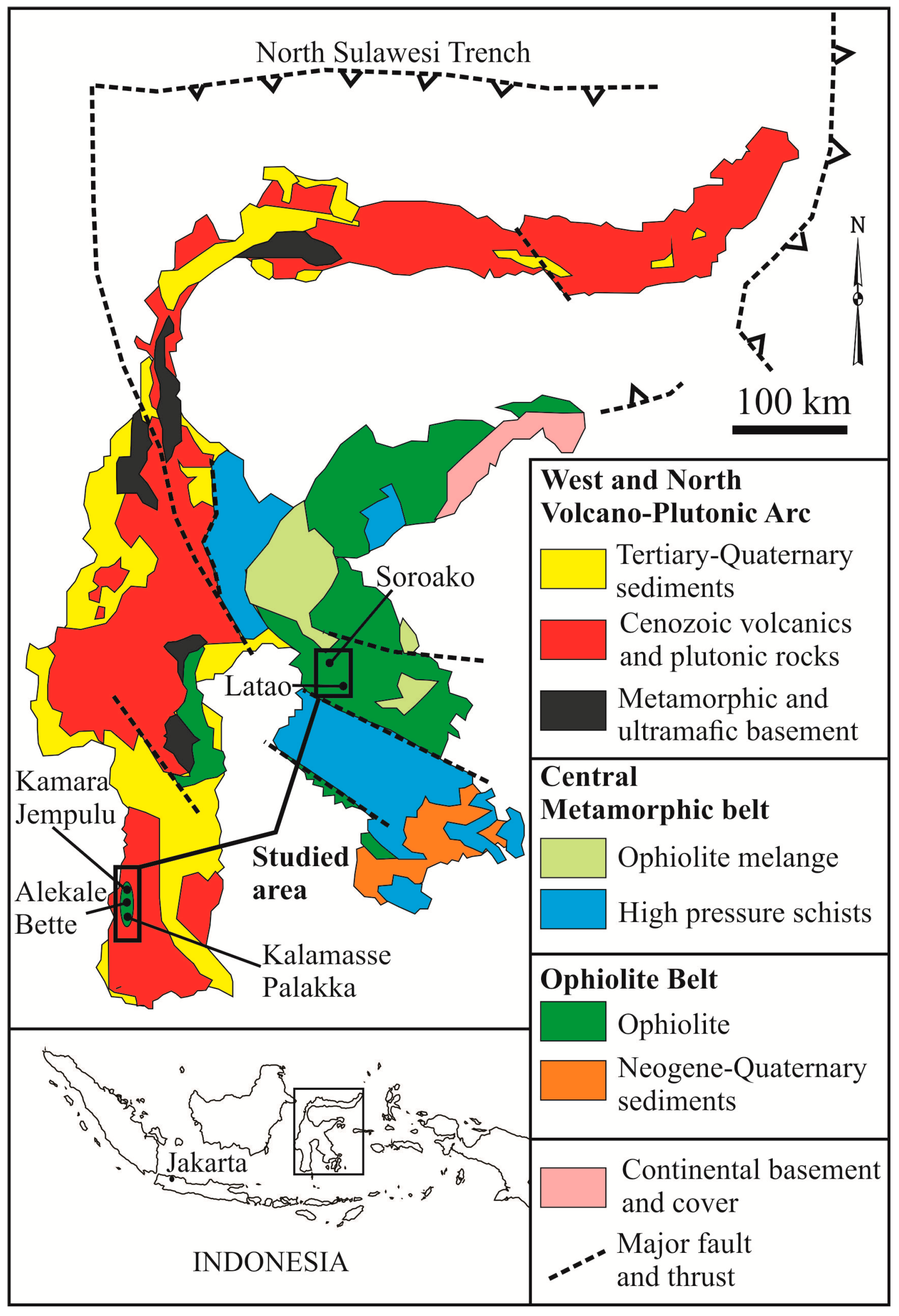

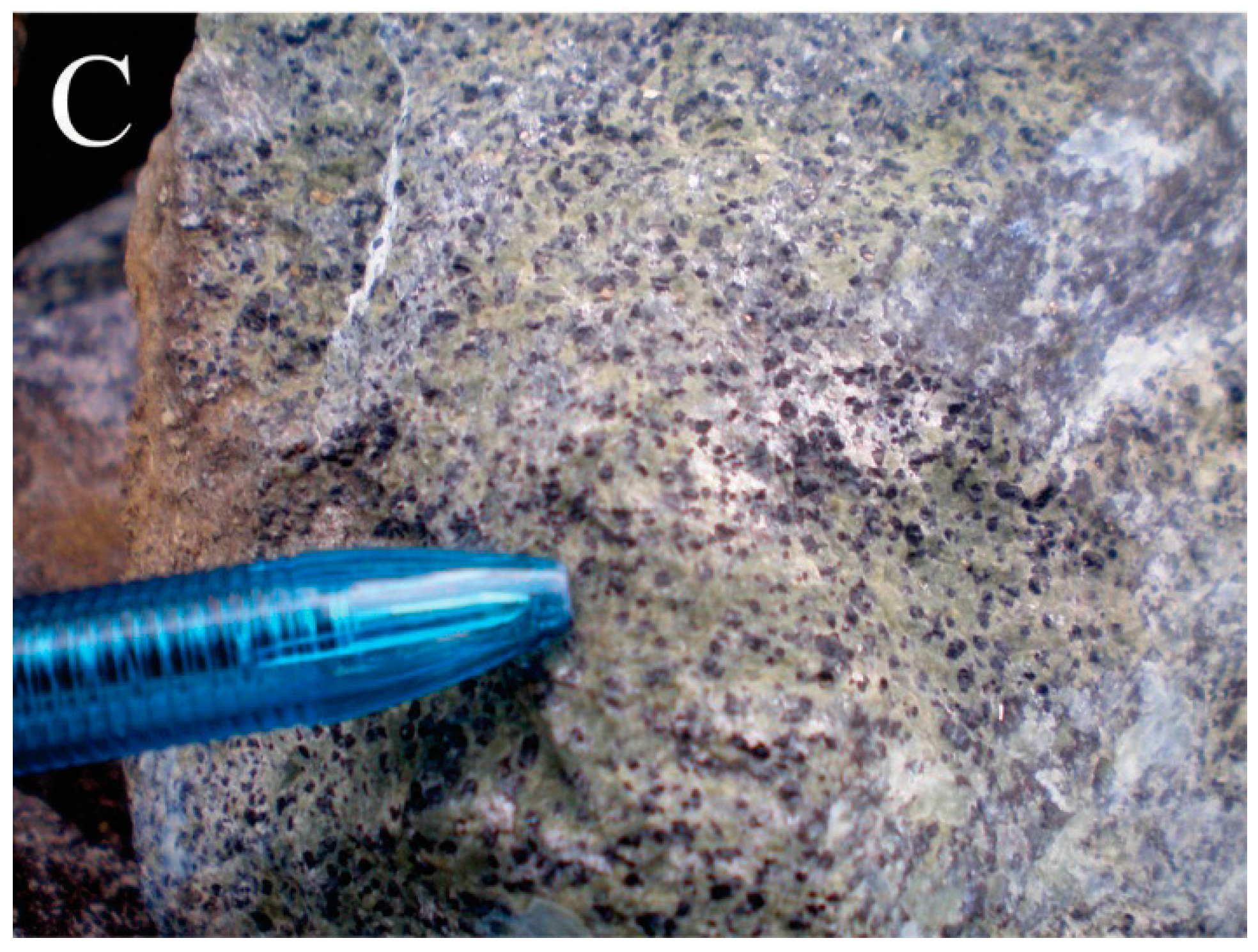
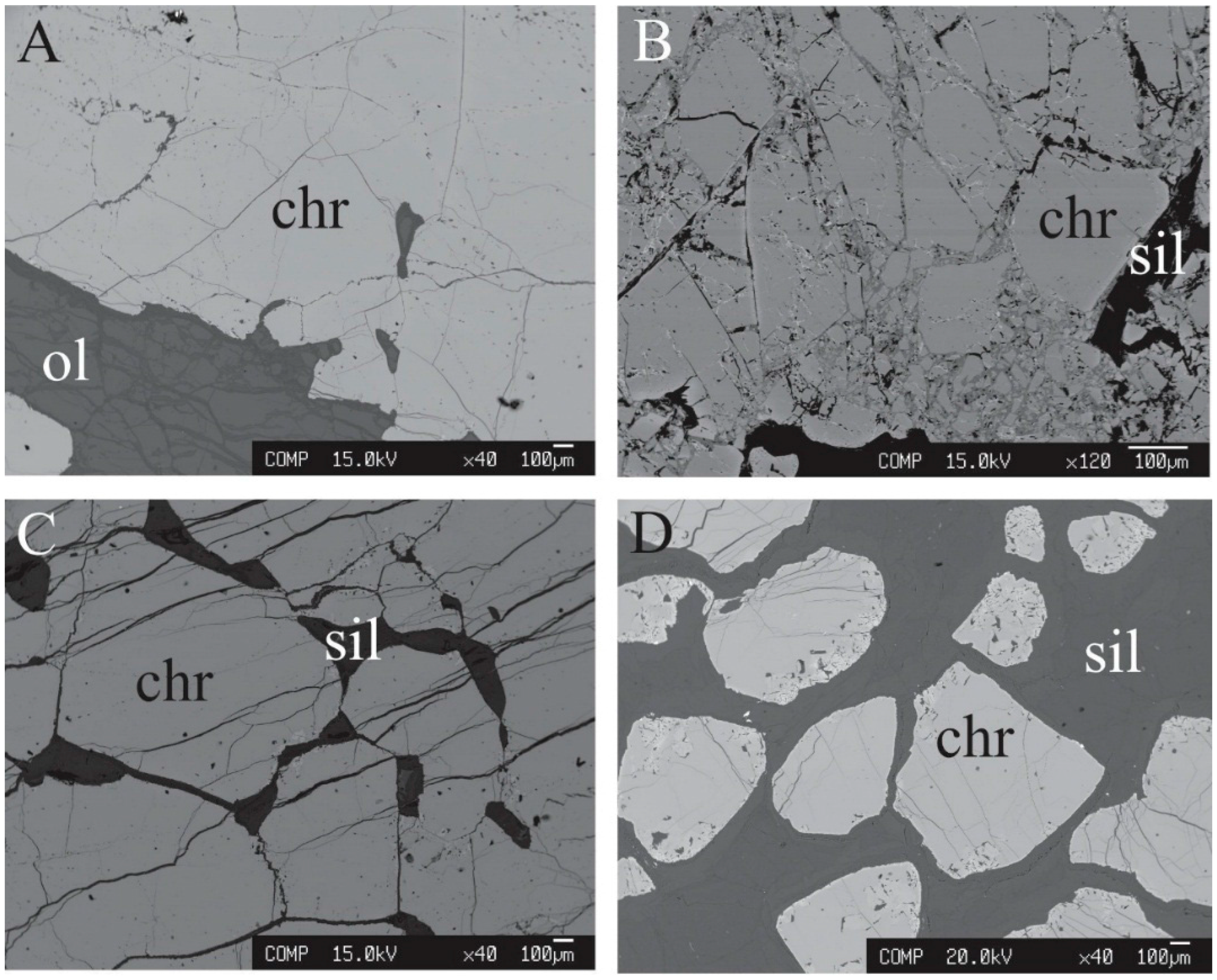
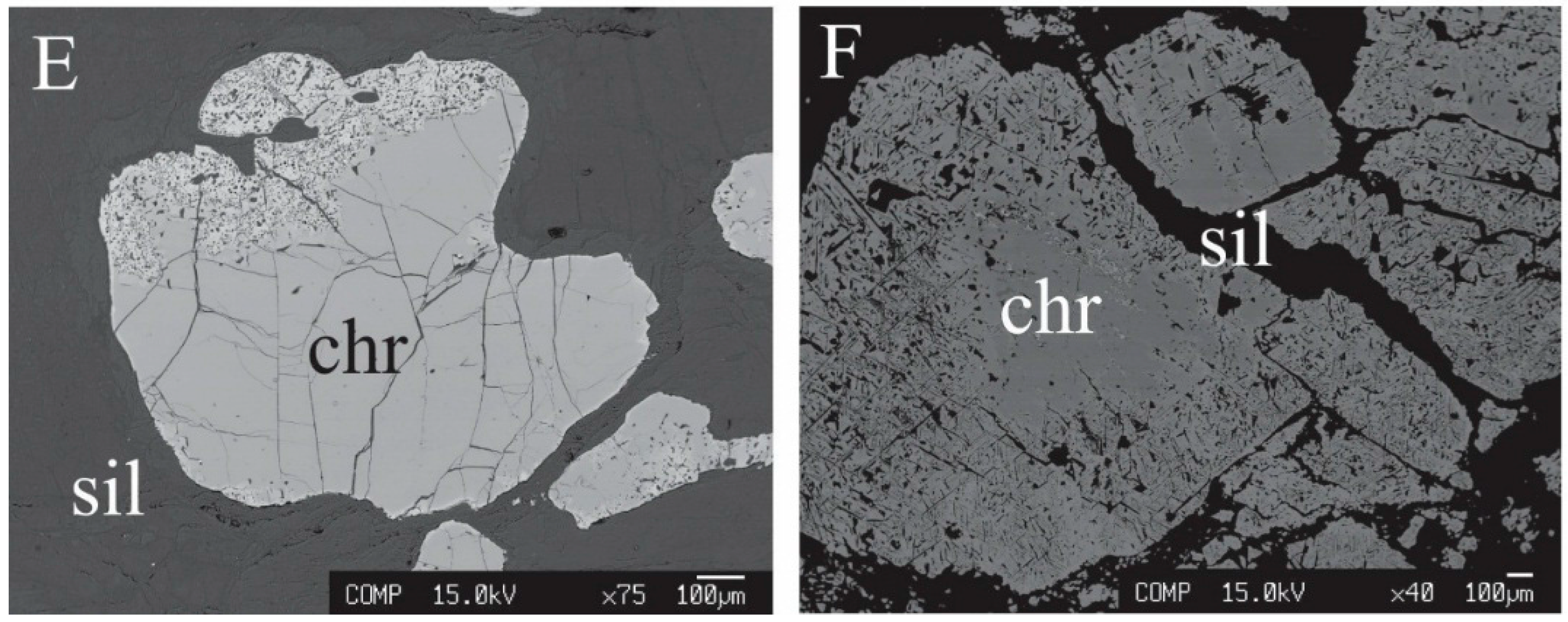
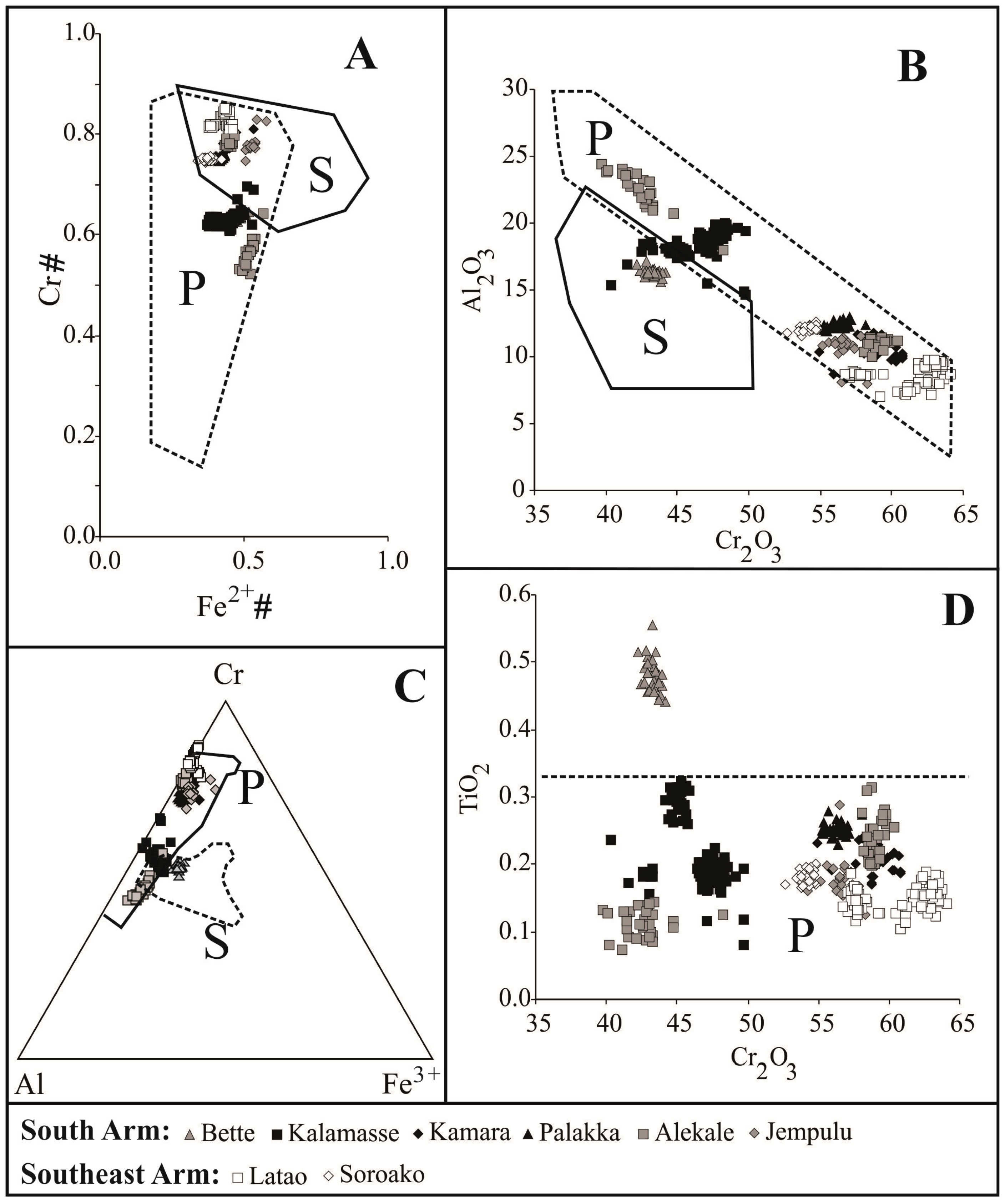
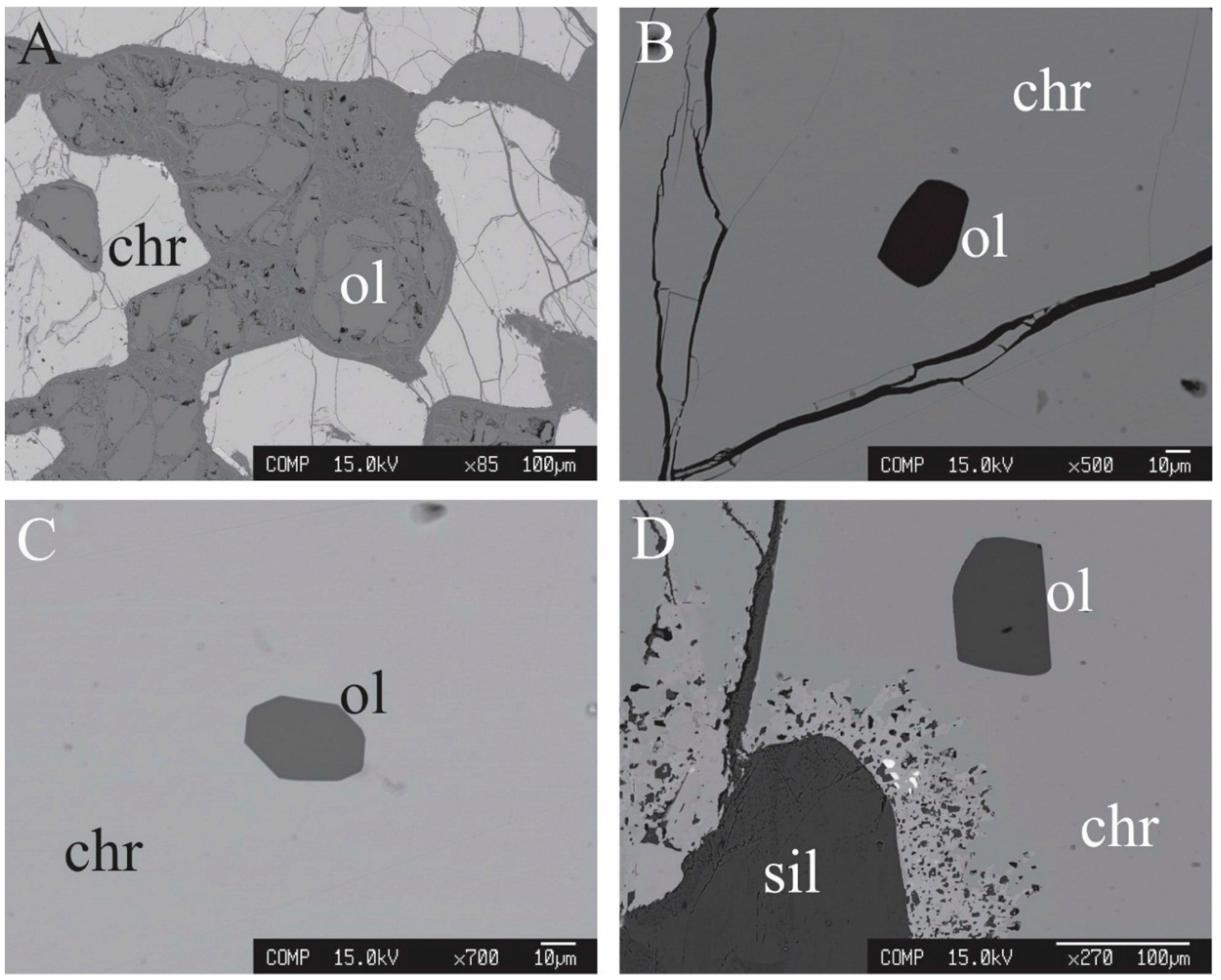
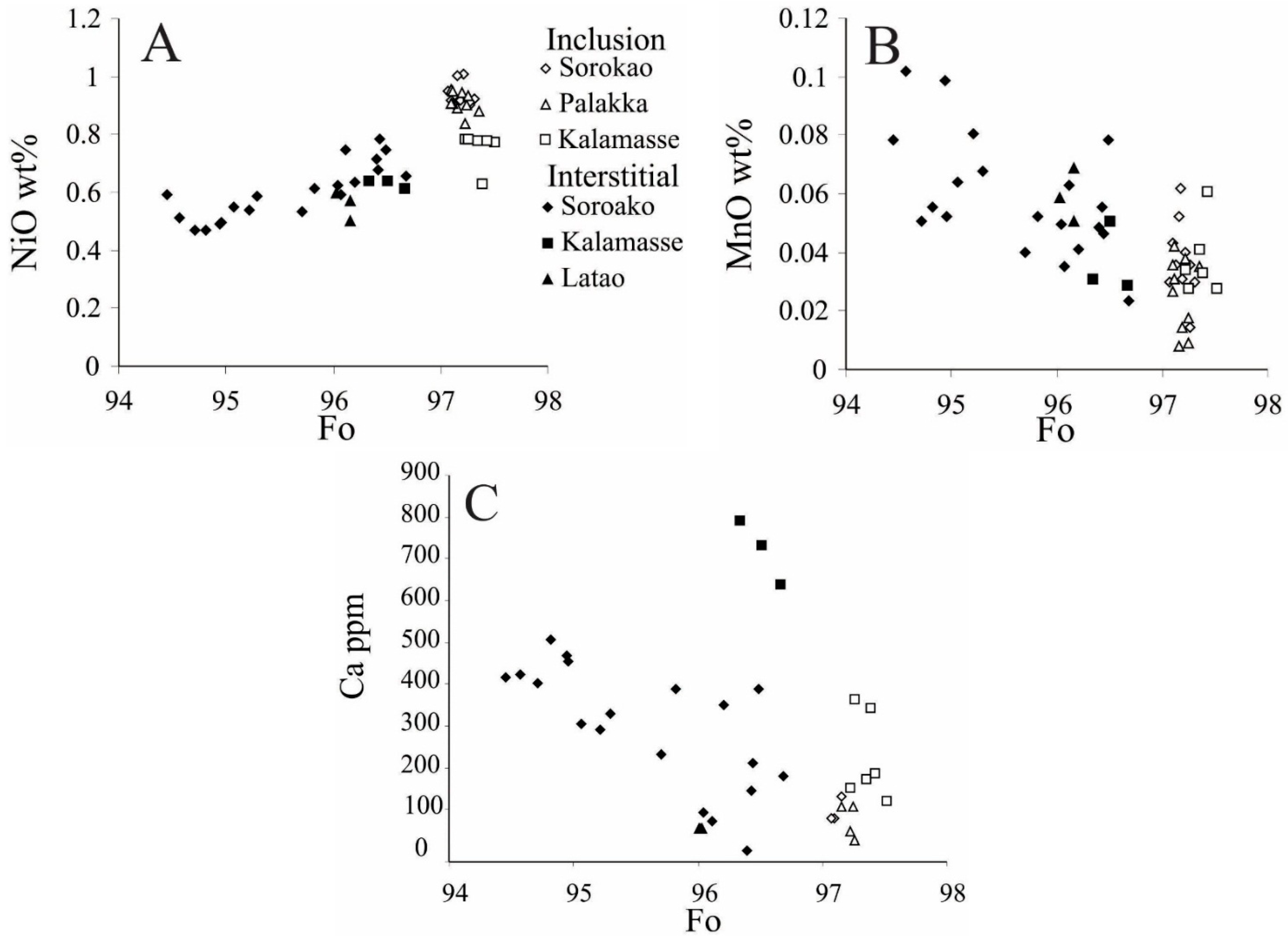
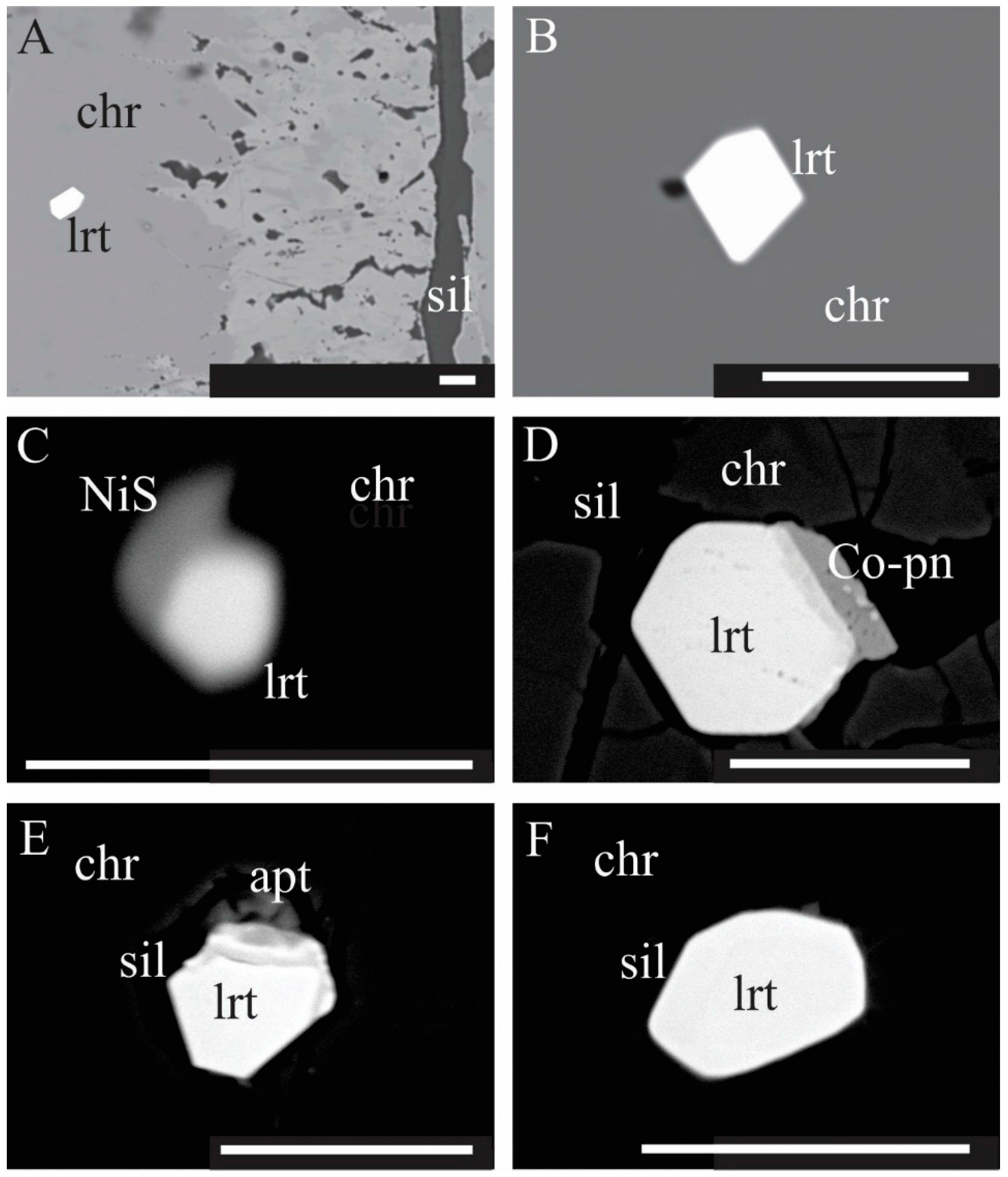
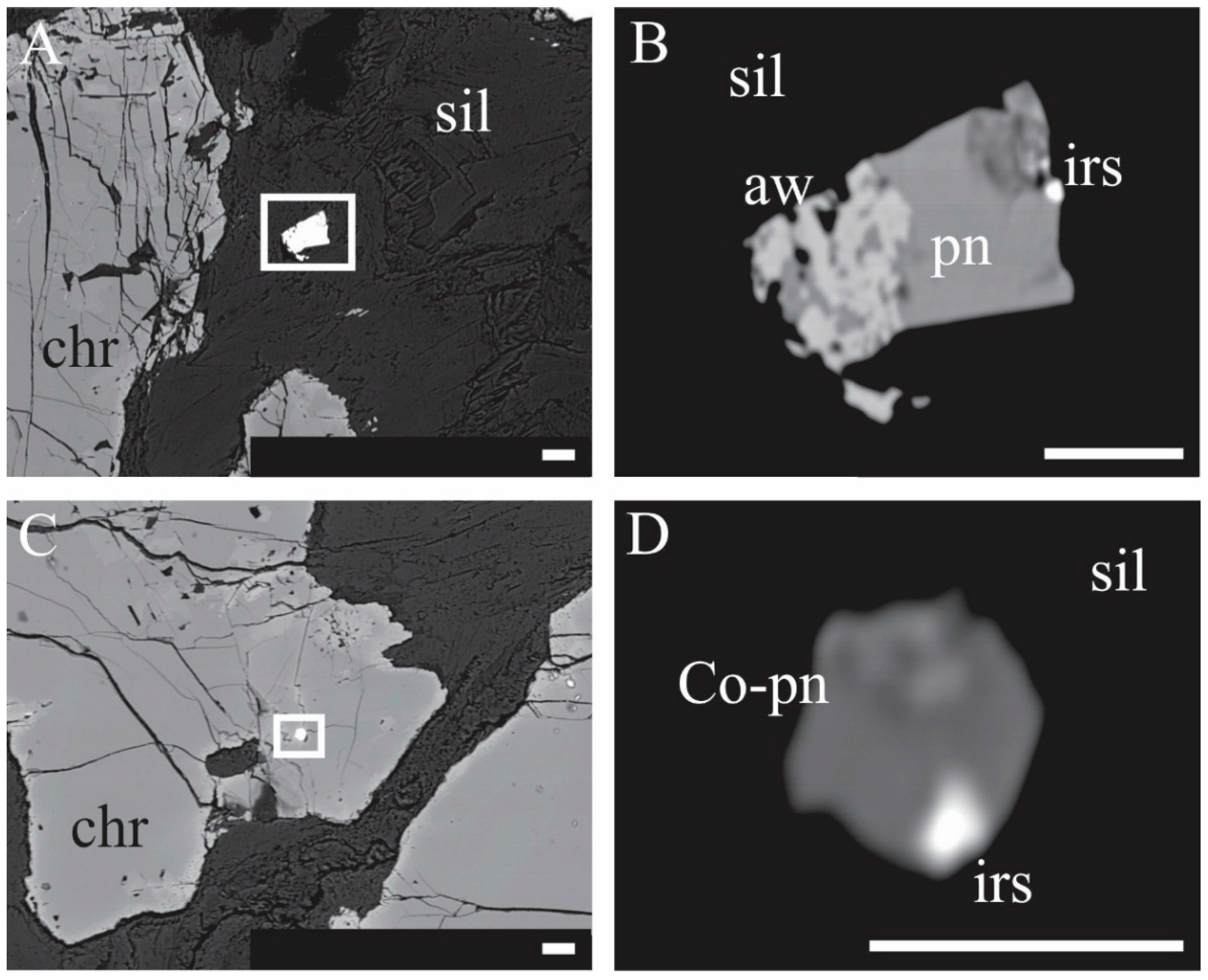
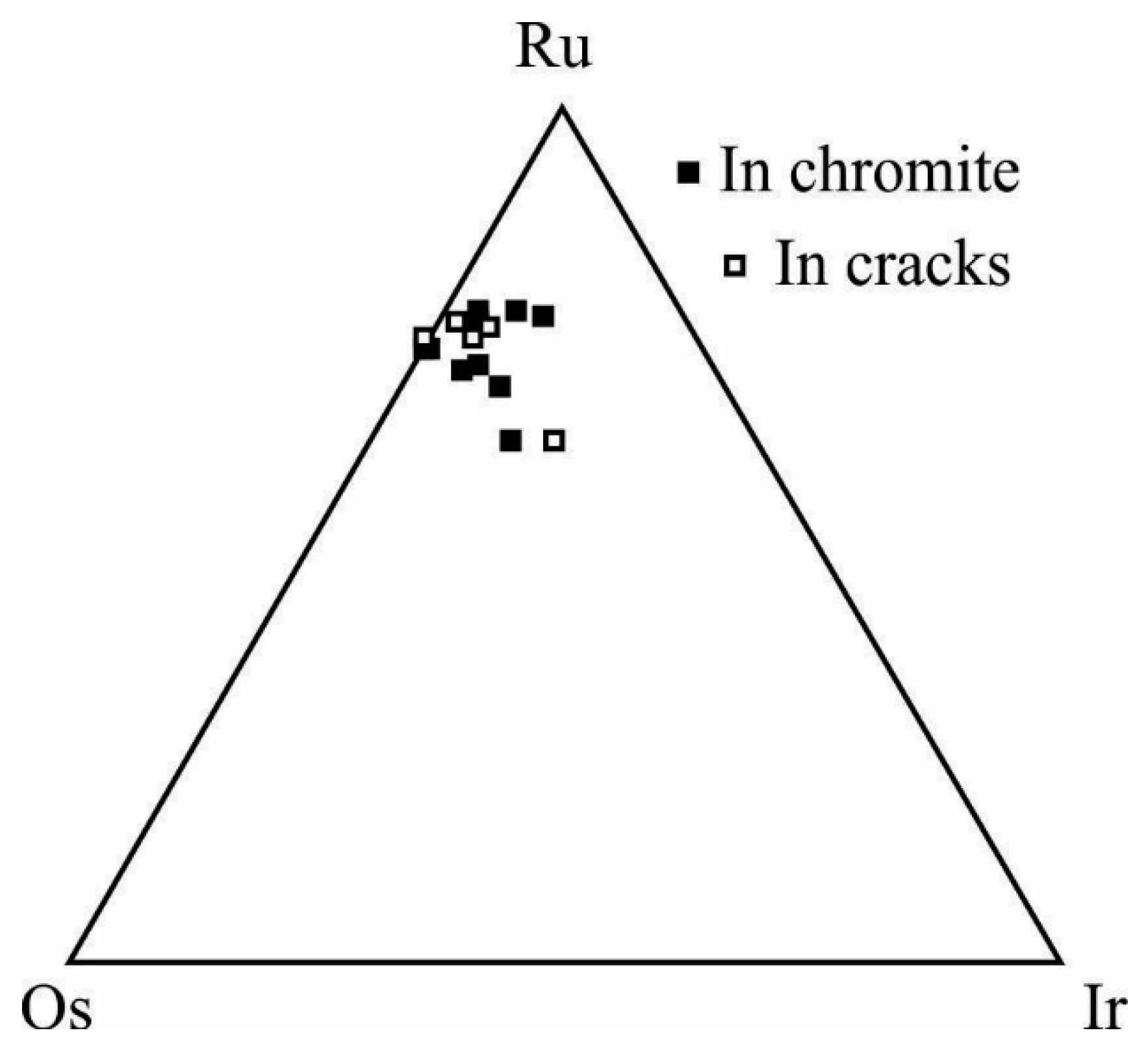


© 2016 by the authors; licensee MDPI, Basel, Switzerland. This article is an open access article distributed under the terms and conditions of the Creative Commons Attribution (CC-BY) license (http://creativecommons.org/licenses/by/4.0/).
Share and Cite
Zaccarini, F.; Idrus, A.; Garuti, G. Chromite Composition and Accessory Minerals in Chromitites from Sulawesi, Indonesia: Their Genetic Significance. Minerals 2016, 6, 46. https://doi.org/10.3390/min6020046
Zaccarini F, Idrus A, Garuti G. Chromite Composition and Accessory Minerals in Chromitites from Sulawesi, Indonesia: Their Genetic Significance. Minerals. 2016; 6(2):46. https://doi.org/10.3390/min6020046
Chicago/Turabian StyleZaccarini, Federica, Arifudin Idrus, and Giorgio Garuti. 2016. "Chromite Composition and Accessory Minerals in Chromitites from Sulawesi, Indonesia: Their Genetic Significance" Minerals 6, no. 2: 46. https://doi.org/10.3390/min6020046





